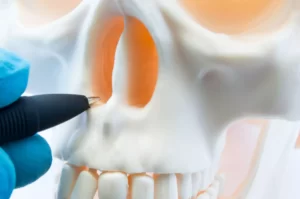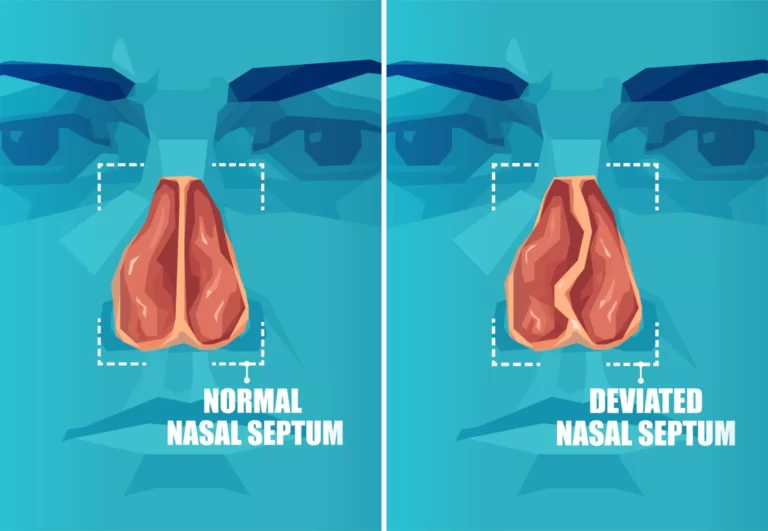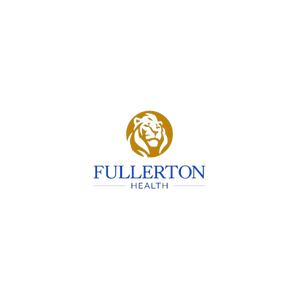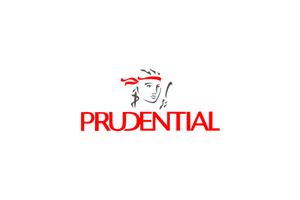Septoplasty
Home | Services | Sinus Conditions | Septoplasty
What Is Septoplasty And Does This Treat A Deviated Nasal Septum?
 This procedure is a surgery performed to correct a deviated nasal septum. The nasal septum is a partition in your nose made from cartilage and bone. It separates the internal nasal cavity into the right and left sides. A deviated nasal septum is used to describe a condition where this partition is crooked, subsequently narrowing one side of the nasal cavity.
This procedure is a surgery performed to correct a deviated nasal septum. The nasal septum is a partition in your nose made from cartilage and bone. It separates the internal nasal cavity into the right and left sides. A deviated nasal septum is used to describe a condition where this partition is crooked, subsequently narrowing one side of the nasal cavity.
Why Do I Need Septoplasty?
The Main Indications For Septoplasty Are:
To Repair A Crooked, Bent Or Deviated Nasal Septum
A deviated nasal septum may block the airway in the nose. Patients with this condition usually have to breathe through their mouth and are hence potentially more prone to mouth breathing, thus affecting their health and health-related quality of life.
Uncontrollable And Persistent Nosebleeds
Such nosebleeds can occasionally occur in patients with a deviated nasal septum. The deviation causes the airflow in the nose to be uneven and no longer laminar, leading to areas in the nose which are drier than others. This dryness can occasionally result in nosebleeds.
To Repair A Hole In The Nasal Septum (Septal Perforation)
Septal perforations can either be iatrogenic (caused by surgery) or acquired. Such perforations may need to be repaired to improve the patient’s quality of life.

What Is The Septoplasty Procedure Like?
This procedure is performed under general anesthesia, and usually takes less than an hour to perform. All the surgical work is done inside your nose and there will be no external incisions or scar formation. To perform the procedure, a cut inside the internal wall on one side of your nose will be made.
- The lining that covers the wall will be lifted up.
- Subsequently, any cartilage or bone that is causing the blockage in the nose will be removed or reshaped.
- The lining will subsequently be put back in place, and will be held in place by stitches, splints, or packing material.
Septoplasty and turbinate reduction may also be performed in the same sitting to achieve the best outcome for patients. Cartilage grafts may need to be taken from your ear to reinforce the nasal framework in select cases. Nasal packing is usually not required, but return visits are necessary after surgery to clean the nasal cavity and monitor the healing process. Postoperative visits are routinely scheduled every 7-14 days until the nose is healing well and then less frequently. You will need to take prescribed medications and irrigating your nose with salt water at least 3-4 times per day. The nose may initially feel more blocked immediately due to swelling after surgery, but this will continue to improve over the next 3-4 weeks as the lining of the nose heals.
How Long Does It Take To Recover From A Septoplasty?
Postoperative visits are routinely scheduled every 7-14 days until the nose is healing well and then less frequently. Flexible nasoendoscopy and cleaning will be performed at each postoperative visit. Patients will need to take prescribed medications and irrigate your nose with salt water at least 3-4 times per day. The nose may initially feel more blocked immediately due to swelling after surgery, but this will continue to improve over the next 3-4 weeks as the lining of the nose heals. Patients are able to go back to regular office work in 1-2 weeks time, and complete healing and recovery is expected in 6-8 weeks.
What Are The Complications of Septoplasty? What are the Risks and Alternatives?
In general the complications and risks of this procedure are minimal. Nevertheless, each patient should be aware of the potential complications.
Bleeding
Bleeding is a possibility in any nasal or sinus surgery as the blood supply is extensive. Occasionally significant bleeding may occur requiring termination of the procedure and nasal packing. This usually requires hospitalization for observation. Blood transfusions are rare, as is the need for subsequent surgery to control bleeding. However, certain precautions are necessary, such as the avoidance of all certain painkillers as well as supplements such as garlic, ginseng, and gingko for a period of 2 weeks before surgery. Patients on long-term blood thinning agents can still undergo surgery though their medication regime or type may need to be temporarily altered.
Failure to Cure the Problem
A deviated nasal septum may not be completely cured by this procedure. The nasal septum is made up of bone and cartilage. Cartilage, in particular, has a very strong memory and it is sometimes impossible to completely straighten the cartilage. As a result, cartilage grafts may be used.
Postoperative Discharge
Postsurgical blood-tinged drainage or clots may occur for up to two weeks after surgery. This is not abnormal and will clear. Blowing of the nose should not be attempted for at least three weeks after surgery.
Risk of Anaesthesia
Although this procedure may be performed under local anesthesia, our preference is for general anesthesia. Although usually safe, general anesthesia has some risks and complications. We can put you in touch with our anaesthesists to discuss this issue further if necessary.
Nasal Collapse (Saddle nose)
The nasal septum supports the external framework of the nose. When cartilage and/or bone is removed from the deviated nasal septum, it can sometimes weaken the support, leading to a saddle nose. Research has shown that certain areas of the nasal septum must be retained to support the external framework. We are highly cognizant of this and do our best to preserve these areas in every case. Saddle nose is thus fortunately extremely rare in this day and age. If such a complication should occur, there are still options for surgical correction.
Nasal Septal Perforation
Nasal septal perforation refers to a through-and-through hole in the nasal septum. This occurs when the lining of the nose on both sides is violated with removal of the intervening cartilage and bone. If this problem were to occur, patients may experience persistent crusting in their nose or a whistling sound when they breathe through their nose. Fortunately with good surgical technique, this has also become a rare complication. If such a complication should occur, it can still be surgically corrected.
Other Risks
Patients may note some temporary numbness or discomfort in the front and upper teeth. Swelling over the nose/face, bruising, “black eyes”, and lip numbness may also occur, but usually resolve in one to two weeks. Air may also collect under the skin around the eye postoperatively which rapidly resolves. Symptoms may return or in some cases worsen such as sinus pain or discomfort, increased nasal obstruction or discharge. Smell may be decreased or absent after surgery, but this is rare. Scarring may occur in the nose, but usually does not cause a problem on occasion the scarring may need to be removed via a separate procedure.
Alternatives to Surgery
This procedure is the treatment of choice for a deviated nasal septum. A deviated nasal septum is an anatomical problem, which cannot be cured with medication. If unsuccessful, you may choose to tolerate the symptoms rather than have surgery.
Does Septoplasty Change Your Nose Shape? What Is The Difference Between Septoplasty And Rhinoplasty?
In general, a simple nasal septoplasty does not change your nose shape. However, if complications such as saddle nose develop, it may lead to a visible change in your nose shape. However, this can also be corrected with surgery.
The main aim of septoplasty is to correct the deviated nasal septum and internal nose issues. This is different from rhinoplasty, which can correct both internal and external nose issues, with the option for cosmetic changes.









